Go to the latest entry...............................Go to previous entry |
|
21 August - We arrived back from a very enjoyable break in Cornwall and South Wales yesterday to be faced with a veritable jungle where the garden should be. It always amazes me how quickly plants will grow when you are not watching them! The mower has been in action and I can see a bit of the water in the pond again today.
Back in early July I watched with interest as a rosette of large leaves grew in a spot where I was trying to grow some teasels. By the time I left for Cornwall a long flower stalk had developed and the picture shows some of the flowers as they were today. I have no idea what this plant is ( Definitely not a teasel! They are are growing next to this plant and photographs will appear in the days to come). The largest leaves now measure some 110cm in length with the 'blade' of the leaf being 65-70cm long and 35-40cm wide. The flower stalk is nearly 170cm tall and the flowers are 9cm across with a central disc of 2cm diameter. This is not a plant that I
have knowingly planted as so far I have not been able to identify
it. The flowers seemed to be very attactive to this insect which spent a very long time in the same spot on the flower. It was not bothered by my presence. When I touched it's back the only response was for it to raise its hind legs as if to push me away. It seems to have some bee characteristics but I need to spend some more time checking though my guides.
Another mystery tonight is this caterpillar, spotted on the underside of a leaf in our Birch tree. It is completely covered with fine white hairs. at the tail there is a tall tuft of red hairs and near the front the segments are topped by densely packed tufts of hair (they look cream in the picture). When I disturbed the caterpillar the black area appeared, looking like a large mouth. To the left of that segment there is another, similar black patch which was only displayed briefly so that the two spots appeared as a pair of eyes(?).
22 August - No time today for photography but I have a couple of updates on yesterday's entry. Thanks to contributors in the uk.rec.natural-history newsgroup I have some ID's. First, Mike Humberston (Barnes, London) has suggested that the flower could well be Telekia speciosa, previously Buphthalmum speciosum, the Yellow Oxeye. The references he gave give it as native to Central and Eastern Europe, although it is available as a cultivated plant. The puzzle still remains as to how it arrived in my garden. I have never seen it in the gardens that surround my home. The caterpillar has been identified by Steve McWIlliam from Liverpool as an early instar of the Pale Tussock (Calliteara pudibunda L.). When I look again through my Collins Guide to Caterpillars of Britain and Europe there is an illustration of it that shows it as covered with black hairs and quite dark compared with the real thing - a poor illustration. Matt Smith has come up with
an interesting ID of the bee (?) on the flower - he says that
it is a species of Coelioxys, a parasitic species that uses Leafcutter
bees as hosts, sneaking As Matt says, I shall have to look out for it flying around the bamboo nest tubes being used by the leaf-cutters.
It has a pair of slender, striped antennae that are held close to the sides of the body when at rest (you can just see them in the lower image) and waved about when disturbed.
On the same branch of the birch was this harvestman (body about 5mm long), minus one of its incredibly delicate legs. My spider guide says that the second legs are used for explore ahead of the harvestman. Unlike their arachnid relatives they do not regenerate lost limbs, so this one will need to tread carefully in future! The close-up image shows the structures (pedipalps?) at the front of the body which seem to be almost claw-like. The Chelicerae, the pair of short, stubby structures right at the front do not contain poison, unlike in the spiders. They are omnivorous, feeding on everything from bird droppings, fungi, small snails and even marmalade (The Larousse Guide to Spiders, Dick Jones). Further to yesterday's entry about the yellow flowers, another newsgroup contributor, Liz S. has come up with what looks like a positive ID in Inula helenium (Elecampane) - an interesting plant with a long list of medical properties that are listed and described in numerous web sites (eg http://www.herbweb.com/herbage/A259.htm). I have been thinking how it could have got here. I wonder whether I bought it as a mis-labelled plant when I bought a number of very small teasel plants early last year. I thought the plants had failed later in the year when they were hidden by other plant growth. The teasels have also produced flower heads for the first time this year ( I shall include a picture of these soon).
The Pale Tussock caterpillar is still about and can be seen feeding at night. However, by the morning it is back under the same leaf where I first spotted it.
A look at the upper branches
of the birch tree this morning revealed a couple of leaf-stalks
that had been stripped. Tapping on the branch was rewarded by
the sight of a squad of Hazel Saw-fly larvae (Croesus septentrionalis)
flicking their tails into the air (see small inserts).
The right hand picture shows some very young larvae. They measure about 7mm in length. They have continuous black stripes along the length of the body and they are as likely to eat holes on the leaf as eat along the leaf edges. By the time they each the size of the larvae pictured above (14mm long) they move in procession from one leaf to the next, devouring the leaf from the outer edge inwards until only the central stalk is left.
The 'Ivy Tree' is covered with flower buds which should open in the next month. This will be good news for a lot of flying insects. Hopefully It will attract some of the butterflies that we have been missing this year. I have not even seen any visiting the buddhlea flowers.
Just after taking the teasel pictures a movement on an iris leaf drew my attention to this caterpillar. About 15mm long it was looping its way along the edge of the leaf. This motion is characteristic of caterpillars of the family 'Geometridae'. I have not been able to identify the species.
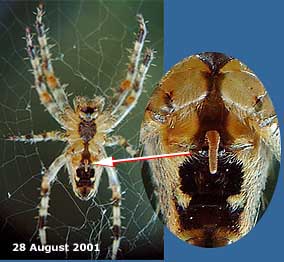
The image on the left, of the underside of the same spider shows a small, protruding structure called the epigyne (arrowed). This is the female gental pore.
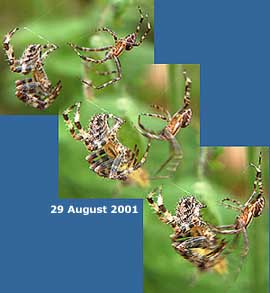
As I watched, this male approached the female occupant of a web. As it moved near her the male pulled on the threads of the web. He paused for a short time about a spider's length from her before dashing in to deposit his sperm at her Epigyne. Unfortunately, my camera can only manage a fast burst of three images so I missed the magic moment of closest contact.The male moved very quickly to the side of the web. It repeated the process a second time ( although I did not capture this) before leaving the nest. The female returned to her position at the centre of the web.
Each one is about 12-13mm long. I am afraid the side view is of poor quality but it shows a light stripe below a dark line on each side of the caterpillar. Yet again I have failed to come up with an ID so far. I have not mentioned the birds in the garden since returning from my holiday. The sparrows are still here in force (30+ today). Other birds come only in ones or twos. Over the last eleven days we have been getting between 5-10 visits from blue tits each day. We also have daily visits by a young robin and collared doves. I have seen the Sparrowhawk visit 6 times and although I have not seen it catch anything my neighbour found a lot of feathers on top of his van, suggesting a kill was made earlier this week. Finally, today I saw a young Dunnock in the garden. This is the first time I have spotted a Dunnock for ages. I shall be watching for return visits in the days to come. |
|
Garden Diary Index..........................................................Next Chapter (September) |
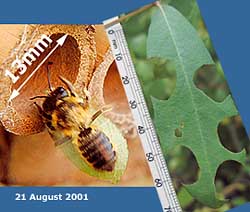 During
our absence leaf-cutter bees moved in and have started using
bamboo tubes, set up near the house. The picture shows my first
attempt to capture a image of one. A number of plants have been
sampled by them, including a rose bush, buddleia and a small
willow tree which is growing in a large pot. This tree seems
to be s favoured source of suitable leaves and most of its foliage
has had chunks removed (one leaf shown here). A bee has also
sampled a bamboo leaf although the chunk was left hanging from
the leaf as if rejected.
During
our absence leaf-cutter bees moved in and have started using
bamboo tubes, set up near the house. The picture shows my first
attempt to capture a image of one. A number of plants have been
sampled by them, including a rose bush, buddleia and a small
willow tree which is growing in a large pot. This tree seems
to be s favoured source of suitable leaves and most of its foliage
has had chunks removed (one leaf shown here). A bee has also
sampled a bamboo leaf although the chunk was left hanging from
the leaf as if rejected.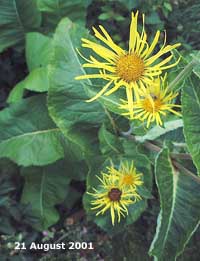
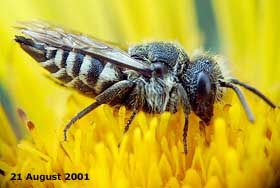
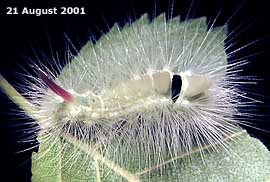
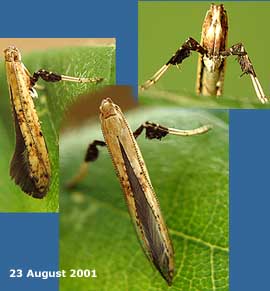 23
August - Two rather
inconspicuous creatures for the diary today. The first is a micromoth
on the birch tree this morning. Measuring about 8mm long, with,
at first glance only one pair of legs. Close examination of the
picture shows this to be two pairs. I cannot work out where the
third pair would be.
23
August - Two rather
inconspicuous creatures for the diary today. The first is a micromoth
on the birch tree this morning. Measuring about 8mm long, with,
at first glance only one pair of legs. Close examination of the
picture shows this to be two pairs. I cannot work out where the
third pair would be.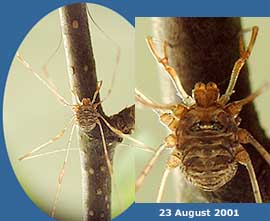
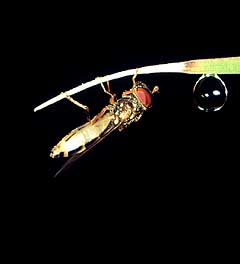 24
August - Two shots
from last night to start with. The first is of a fly roosting
on a bamboo leaf next to a drop of sap released by the plant.
By the morning the lower leaves are often covered with this sap
which in turn attracts hoverflies and other insects.
24
August - Two shots
from last night to start with. The first is of a fly roosting
on a bamboo leaf next to a drop of sap released by the plant.
By the morning the lower leaves are often covered with this sap
which in turn attracts hoverflies and other insects.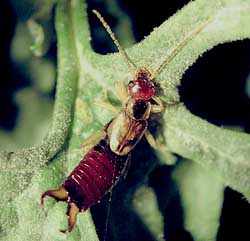
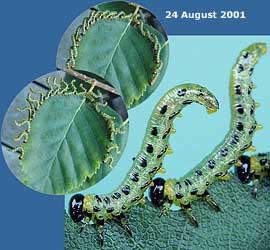
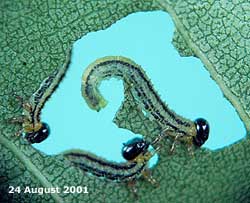
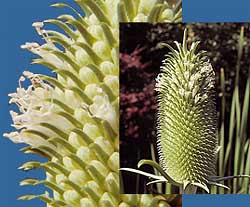 27
August 2001 - A couple
of days ago I mentioned the Teasel (Dipsacus fullonum).
This morning I could see the first flowers opening. Teasels flower
between July and August so my plants are rather late.
27
August 2001 - A couple
of days ago I mentioned the Teasel (Dipsacus fullonum).
This morning I could see the first flowers opening. Teasels flower
between July and August so my plants are rather late.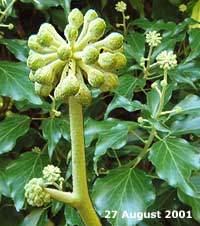
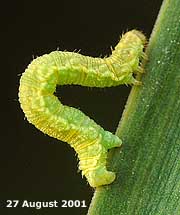
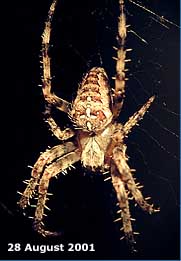
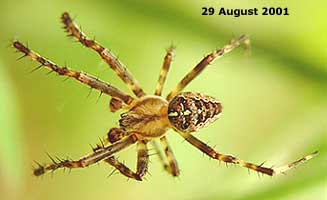 29
August - Following
yesterday's pictures of the Garden Spider female, here is a picture
of a mature male. Smaller than the female (see below), it posesses
a pair of enlarged palps at the front end of the body. While
both sexes have palps, in the male they are club shaped and used
to carry a packet of sperm that it has collected from its genital
pore.
29
August - Following
yesterday's pictures of the Garden Spider female, here is a picture
of a mature male. Smaller than the female (see below), it posesses
a pair of enlarged palps at the front end of the body. While
both sexes have palps, in the male they are club shaped and used
to carry a packet of sperm that it has collected from its genital
pore.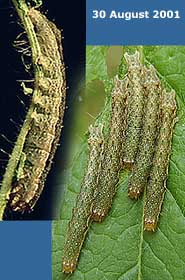 30
August - Just the one
image today. These caterpillars were spotted on a leaf of Rose-Bay
Willowherb. During the day they spent all their time stationary
in groups like this one or single file along the stem and leaf
stalks. They only moved about after dark.
30
August - Just the one
image today. These caterpillars were spotted on a leaf of Rose-Bay
Willowherb. During the day they spent all their time stationary
in groups like this one or single file along the stem and leaf
stalks. They only moved about after dark.